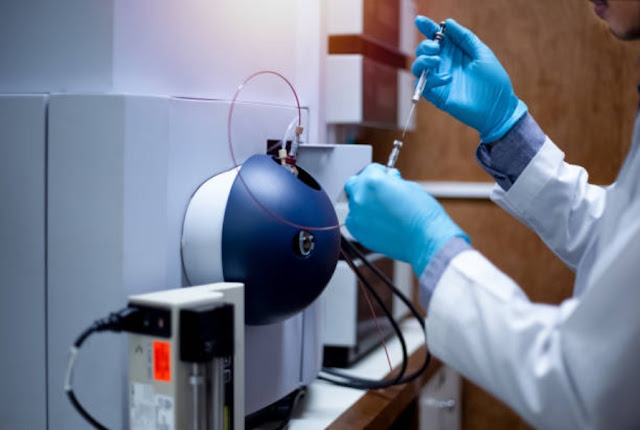Advancements in Analytical Technology

Mass spectrometry is a powerful indicative technique in
various fields, including chemistry, biology, pharmacology, and environmental
science. It enables molecule identification, quantification, and structural
characterization based on their mass-to-charge ratio. Over the years, mass
spectrometry has undergone significant advancements, leading to improved
sensitivity, resolution, and analytical capabilities. This article explores the
principles, applications, and recent developments in mass spectrometry
technology.
Principles of Mass Spectrometry:
Mass spectrometry involves three main steps: ionization,
mass analysis, and detection. The process begins with converting molecules into
ions through various ionization techniques, such as electrospray ionization
(ESI) or atmosphere-abetted laser desorption/ionization (MALDI). These
techniques generate ions with different charge states, allowing for a wide
range of molecules to be analyzed.
Using mass analyzers, the ions are then separated and sorted
based on their mass-to-charge ratio (m/z). Standard mass analyzers include
quadrupole, time-of-flight (TOF), and ion trap analyzers. Each analyzer has its
advantages, such as high-resolution capabilities or enhanced sensitivity.
Finally, the ions are detected, and their abundance is
measured. Detectors, such as electron multipliers or photomultiplier tubes,
convert the ions into electrical signals that computer systems record and
analyze.
Applications of Mass Spectrometry:
Mass spectrometry has diverse applications across scientific
disciplines:
Proteomics: Mass spectrometry plays a vital role in
proteomics research, allowing the identification and characterization of
proteins. It facilitates the analysis of protein modifications, protein-protein
interactions, and protein quantification. Techniques like liquid
chromatography-mass spectrometry (LC-MS) enable comprehensive proteome
profiling and biomarker discovery.
Metabolomics: Mass spectrometry is used in metabolomics to
study the metabolic profile of biological systems. It allows for identifying
and quantifying small molecules, metabolites, and their transformations.
Metabolomics helps in understanding metabolic pathways, biomarker discovery,
and disease diagnostics.
Drug Discovery and Development: Mass spectrometry is used in
drug discovery and development for drug metabolism studies, pharmacokinetics,
and quantification. It aids in identifying and characterizing drug metabolites,
studying drug-drug interactions, and determining drug stability.
Environmental Analysis: Mass spectrometry is employed in
environmental science to analyze pollutants, contaminants, and environmental
samples. It identifies and quantifies organic compounds, pesticides, and toxins
in air, water, and soil samples. Mass spectrometry is crucial in monitoring
environmental health and ensuring regulatory compliance.
Forensic Science: Mass spectrometry plays a crucial role in forensic analysis, allowing the identification and analysis of trace evidence, drugs of abuse, and toxins. It aids in forensic toxicology, arson investigation, and identification of illicit substances.
Recent Technological Advancements:
Mass spectrometry technology continues to advance, driven by
innovations in ionization techniques, mass analyzers, and data analysis
methods. Some notable advancements include:
Ambient Ionization Techniques: Ambient ionization
techniques, such as desorption electrospray ionization (DESI) and direct
analysis in real time (DART), allow for the direct analysis of samples without
extensive sample preparation. These techniques enable rapid and in situ
analysis, making them valuable in fields like clinical diagnostics and food
safety.
High-Resolution Mass Spectrometry: High-resolution mass
spectrometry provides increased resolving power, allowing for more accurate
analysis of complex samples. Orbitrap and Fourier-transform ion cyclotron
resonance (FT-ICR) analyzers are high-resolution mass spectrometry technology
examples. They offer superior mass accuracy, enabling the identification of
isotopes, elemental compositions, and structural elucidation of molecules.
Imaging Mass Spectrometry: Imaging mass spectrometry
combines mass spectrometry with spatial information, allowing the visualization
and mapping of molecules within biological tissues. This technique enables the
analysis of molecular distributions, biomarker localization, and spatial
metabolomics, providing valuable insights into tissue functionality and disease
pathology.
Conclusion:
Mass spectrometry technology has transformed analytical
chemistry and contributed to various scientific fields. It enables precise
identification, quantification, and structural analysis of molecules, playing a
crucial role in proteomics, metabolomics, drug discovery, environmental
analysis, and forensic science. Recent advancements in ionization techniques,
high-resolution mass spectrometry, imaging, data analysis, and miniaturization
have expanded the capabilities and applications of mass spectrometry. As
technology continues to evolve, mass spectrometry will continue to provide
valuable insights into the molecular world, driving scientific discoveries,
improving healthcare diagnostics, and addressing environmental challenges.


